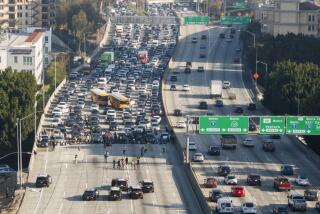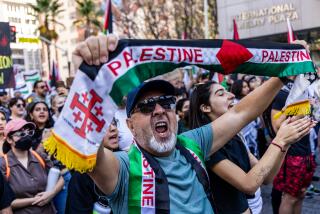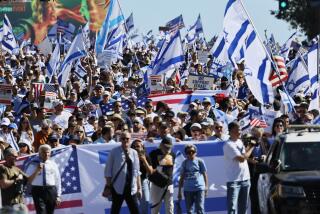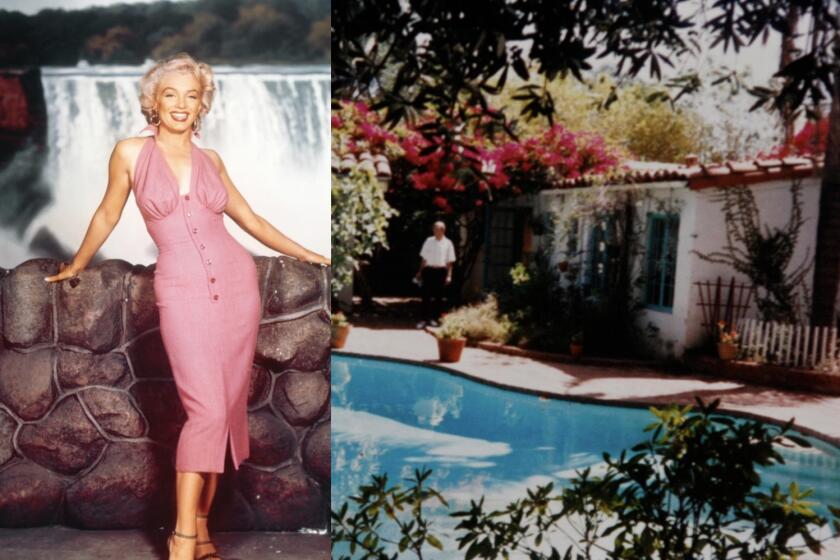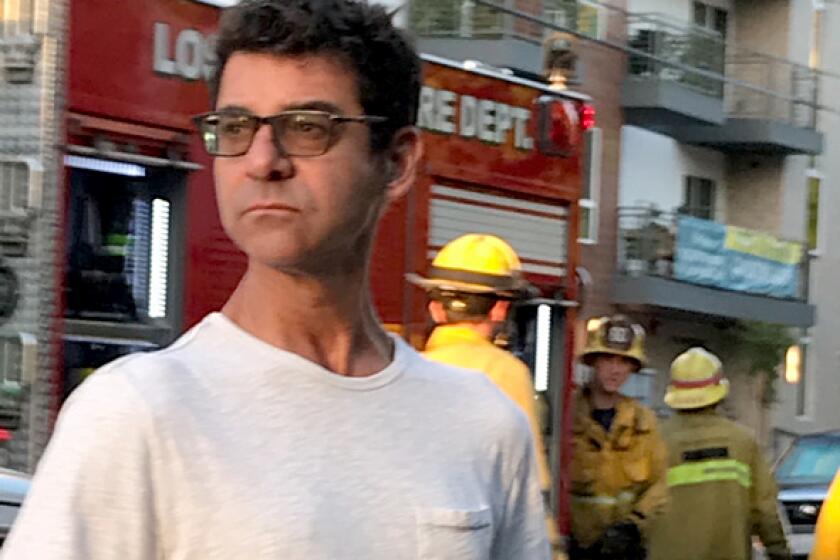Marchers fill L.A.’s streets
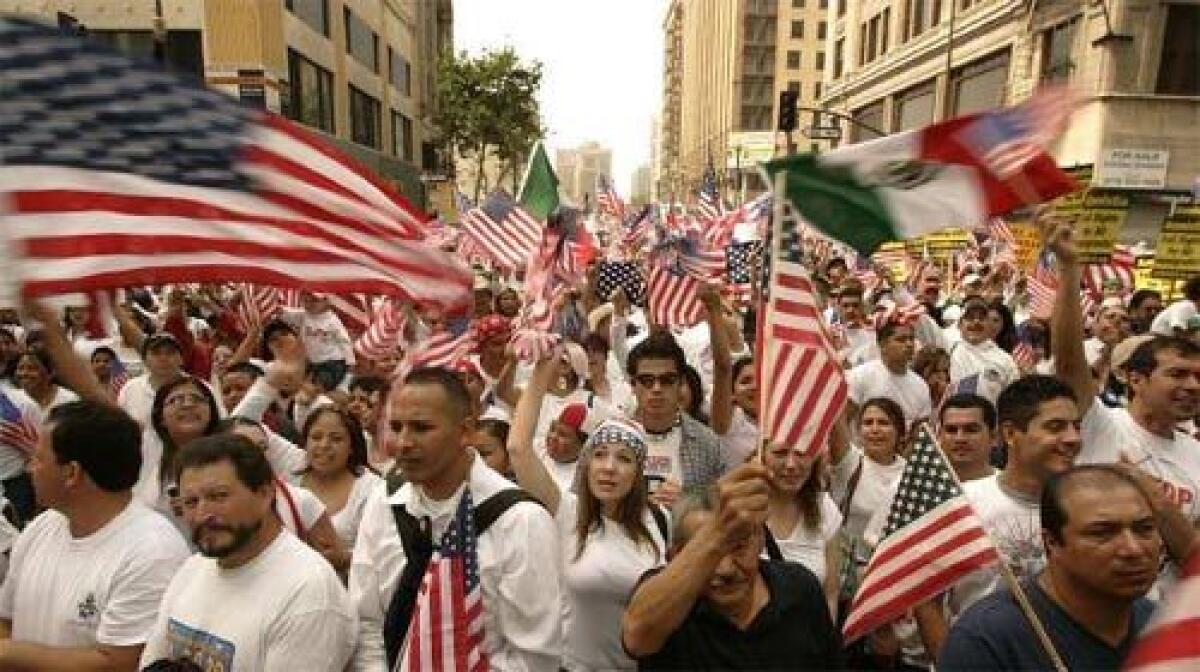
Feeling power in their numbers, hundreds of thousands of people marched peacefully, even joyously, through the streets of Los Angeles on Monday as part of a nationwide demonstration of economic and political clout by immigrants -- legal and illegal.
Thousands of businesses were shuttered on the “Day Without Immigrants” as workers and their families, most of them from Mexico, participated in a boycott of work and commerce, rallying to demonstrate their importance to the U.S. economy and to demand changes in immigration law that would give illegal migrants a path to citizenship.
A crowd estimated by Los Angeles police at 250,000 marched to City Hall in the morning, after which many determined demonstrators made their way, on foot or by subway, to MacArthur Park for a larger march along Wilshire Boulevard. Police estimated that crowd at 400,000 and reported few problems.
“I want to come out of the shadows,” said Josefina Cordoba, 46, of El Sereno, an undocumented immigrant from Mexico who joined six family members on the City Hall march. A cleaning woman who earns $70 a day, she said it was worth losing a day’s wages to make her case. She clutched a small poster that summed up the sentiments of many: “We Just Want a Taste of the American Dream.”
The demonstrations in Los Angeles were the largest among the immigrant rights’ protests held around the nation, including gatherings in Chicago, New York and Houston. And the boycott apparently received substantial support -- nearly stopping commerce at the nation’s largest port complex. Elsewhere in the region, at least 15,000 people marched in Santa Barbara, 10,000 in Santa Ana, 8,000 in Huntington Park and a few thousand in the Inland Empire, according to official estimates.
In San Ysidro, about 1,000 protesters on both sides of the U.S.-Mexico border blocked lanes into the United States for about an hour at midday, bringing traffic to a standstill. Eventually, protesters were pushed back by Mexican police, who arrested about two dozen people.
The demonstrations followed a massive March 25 rally in downtown Los Angeles that drew half a million people, primarily to protest an immigration bill passed by the U.S. House of Representatives that would have made illegal immigration a felony.
With that bill’s prospects apparently dimmed, Monday’s protesters appeared emboldened and ready to amplify their political voice. A major theme of the day was summed up by signs that read: “Ahora marchamos, manana votamos” -- (Today We March, Tomorrow We Vote.)
“If you want something, you have to fight for it,” said Jaime Torres, 19, an illegal immigrant from Jalisco, Mexico, and a student at Los Angeles City College. “We have to be respectful, but we have to raise our voices.”
The boycott was felt in patches throughout Southern California. In some areas with large Latino populations, nearly every business was closed for the day; in other spots, especially those served primarily by large national chains, most if not all were open.
Traffic was a snarled mess in areas close to the demonstrations, primarily in downtown Los Angeles and along the Wilshire corridor. But in much of Southern California, the day without immigrants turned out to be a day -- or at least a morning -- without traffic.
“From the Hollywood sign to downtown took me 10 minutes,” said Graham Marriott, 58, of Toluca Lake. “It was like driving to the office on a Sunday at 3 a.m. It was great. It should happen more often.”
Not everyone was happy with the demonstrations. Although many U.S. citizens embraced the immigrants’ cause, others were indifferent or hostile.
“It’s interesting that the rest of us didn’t get a day off from paying for services,” said Ira Mehlman, a spokesman for the Federation for American Immigration Reform, which supports much tougher enforcement of immigration laws. “We’ve got only a partial picture what life would be like if we didn’t have millions of illegal immigrants here.”
At a closed Burger King in Pomona, the management posted a sign in English and Spanish: “Sorry, Our Employees Didn’t Report to Work. Thank You for Being a Loyal Customer.”
Above the announcement, someone scrawled: “Fire Them.”
At the Northridge Fashion Center Mall, at least one patron said she was sympathetic to immigrants but didn’t understand the point of the protests.
“Are we supposed to see what it’s like without immigrants?” asked Kim Kelly of Porter Ranch. “Because nothing seems different today for me.”
The city picked up her trash on schedule in the morning, she said. “But,” she added. “I’m wondering if the gardeners will come.”
In some sectors, however, immigrant workers’ absence was keenly felt.
Trucking companies that serve the ports of Los Angeles and Long Beach estimated that up to 90% of their drivers did not report to work, virtually halting the flow of cargo containers to and from terminals.
“Hardly any of the owner-operators were at the container terminals of either port,” said Bob Curry, president of California Cartage, one of the largest trucking lines in the harbor. “We are all concerned. Everyone loses money in something like this.”
Curry said it might take up to a week to clear the cargo stalled by the immigration boycott.
Though there was no way to immediately assess the larger effects of the protests, they did appear to mark a newfound sense of confidence on the part of illegal immigrants, who until recently have generally been reluctant to participate in civic debate.
“For many years, these undocumented immigrants, as well as individuals who sympathize with the plight of this community, have been very quiet and passive,” said Harry Pachon, president of USC’s Tomas Rivera Policy Institute, a think tank that studies Latino issues. That is changing, he said. “When you have 100,000 people out in the street, that gives reality to potential political power.”
Pachon said the fact that so many immigrants are willing to skip work and let their voices be heard shows that they are no longer afraid. “There is also safety in numbers,” he added.
Monday’s protests resembled the March 25 demonstration in many ways, but seemed more energetic and boisterous. “Today we feel victorious,” Alejandra Arcasi, a 40-year-old naturalized citizen from Peru, said as she marched toward City Hall. “But there is still a lot more to do.”
Marching up Broadway, demonstrators chanted in front of open businesses, demanding -- in some cases successfully -- that they close.
Apparently taking stock of complaints about the number of Mexican flags in previous demonstrations, organizers made sure that the vast majority of marchers Monday carried American flags. However, many still carried Mexican flags, sometimes alongside -- or above -- the Stars and Stripes.
Just as in March, most were wearing white shirts and many brought their entire families. Despite the economic boycott, vendors were plentiful, selling water, noisemakers, hot dogs, flags and sodas. A red blimp flew above the crowd, covered in U.S. flags.
The first march began at Olympic Boulevard and made its way up Broadway to 1st Street, ending at City Hall. There, a series of speeches were book-ended by a loud recording of Neil Diamond’s “America:” Everywhere around the world / They’re coming to America. / Every time that flag’s unfurled / They’re coming to America.”
“These people out here want to be a part of the American dream,” Mayor Antonio Villaraigosa said of the protests. “I support them.”
Although several public figures, including Villaraigosa and Cardinal Roger M. Mahony, urged students to stay in school, the crowd included many schoolchildren.
“We want to show the government that a day without a Mexican makes a difference, that Mexicans help America, that they give them money,” said Melissa Covarrubias, 15, who called in sick to El Rancho High School in Pico Rivera.
The Los Angeles Unified School District reported 71,942 absences in grades 6 through 12 on Monday, or about 27% of the total enrollment in those grades. By contrast, the absentee rate was 10% on the same day last year.
Among the protesters at City Hall was restaurant worker Chris Zamora, 23, who could hardly contain his delight at the spectacle surrounding him.
Unfurling a banner that read “Legalize, Don’t Criminalize,” he said: “In my studies, I learned that there were demonstrations like this in Los Angeles during the Vietnam War. So it gives me chills to be a part of it. Thirty years from now, I’ll look back and say, ‘I was there.’ ”
Zamora’s mother, Lillia, who immigrated to the United States from Mexico in 1997 and later become a citizen, added: “It’s not right that people should be dying as they cross the border,” she said, “simply to find a job and support their families.”
Juan Pino, 44, watched the march from his post as a security guard at the Anjac Fashion Buildings on Broadway. Pino said his boss told him he would be fired if he didn’t show up.
“It’s bad,” Pino, who waved an American flag as marchers passed by. “They should have let us participate.”
Also in the crowd, but on the other side of the political spectrum, were three friends from West Los Angeles and Santa Monica.
The women said they struggle to get housing, employment and healthcare, competing against what they see as an unfair crush of illegal workers.
“I can’t afford glasses and healthcare,” said Linda Carrillo, 50, a home health aide for AIDS patients. “Our neighbors, who are illegal immigrants, have cellphones and drive SUVs.”
Carrillo is married to a Mexican American and speaks fluent Spanish. She said she loves the Latino culture, but bristles at the belief by some that they are entitled to live here illegally. On her sign was an American flag and a single word: “Adios.”
It was standing room only on Red Line subway cars heading from downtown Los Angeles to MacArthur Park, where the day’s second major immigration march began at 4 p.m., moving west on Wilshire Boulevard to La Brea Avenue.
As at the earlier demonstration, the Wilshire march was peaceful, with something of a fiesta atmosphere, although afterward about 100 rowdy demonstrators faced off with police, some throwing bottles and breaking windows. Police arrested two males on suspicion of assault with a deadly weapon after an officer was hit in the chest.
Also in MacArthur Park, three men set fire to the corners of two plastic American flags using cigarette lighters and held them up to the crowd. After the flags were burned, someone threw an object at the men, hitting them.
Earlier, at the Wilshire march, Gilma Hererra, 8 1/2 months’ pregnant, was pushing a stroller carrying her 2-year-old son. “Most of us who work here are illegal and there aren’t many Americans who will do what we do,” said Herrera, 24, who is from San Salvador and cleans houses.
“If we didn’t come, who will build the houses?” asked Jose Abrego, 40, from Acapulco.
Abrego came in July to do construction work so he could save money to build his own house back home, where he earned about $100 a week driving trucks. Here he earns about $400 a week. “We are asking the rich of the United States to respect us.”
Juan Medina said he painted houses Monday because, “I need to work.” But then he came to watch the demonstration from the sidelines.
“This is America,” Medina, 54, from Guatemala, said as the crowds filed in front of him. “This is the first time in my life I have seen something like this. This is why everyone wants to be here.”
Some onlookers along the route took a more dispassionate view.
“They do have the right to march, but we’re spending a lot of taxpayers’ money right now with all of the police and firefighters along Wilshire, and all the closed businesses,” said John Stanford, a real estate agent. But, he said, “there’s a lot of positive energy here. Positive faces.”
Further along, commercial photographer John Skalicky, 46, admitted to mixed emotions
“On this issue I am very torn,” he said from the sidewalk while a sea of immigrants occupied the street. “This is very emotional to see all of these people and know they are working hard to improve their lives. But there is a little fear that Los Angeles will change too much.”
At the end of the day, some protesters were reluctant to return home. Scores of them headed from MacArthur Park downtown, where they gathered on the steps of City Hall.
“It wasn’t planned, but the people just started to walk,” Enrique Acevedo, a 19-year-old undocumented college student in Riverside, said of the second City Hall rally of the day. “This is the most important building in Los Angeles -- City Hall. That’s why we wanted to end the protest here.”
CONTRIBUTORS
The following Times staff writers contributed to this report: Jonathan Abrams, Sandy Banks, Andrew Blankstein, Cynthia H. Cho, Juliet Chung, Nancy Cleeland, Jennifer Delson, Lynn Doan, Jason Felch, Jessica Garrison, John M. Glionna, Larry Gordon, Gregory W. Griggs, Jean Guccione, Erika Hayasaki, Duke Helfand, J. Michael Kennedy, Evelyn Larrubia, Jill Leovy, Dan Morain, Jennifer Oldham, Sam Quinones, Jordan Rau, Lisa Richardson, Joel Rubin, Catherine Saillant, Deborah Schoch, Kelly-Anne Suarez, Dan Weikel, Kenneth R. Weiss, Janet Wilson and Richard Winton.
More to Read
Start your day right
Sign up for Essential California for news, features and recommendations from the L.A. Times and beyond in your inbox six days a week.
You may occasionally receive promotional content from the Los Angeles Times.
